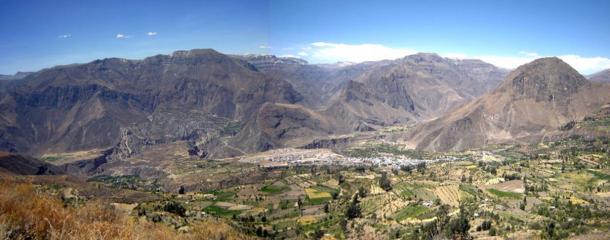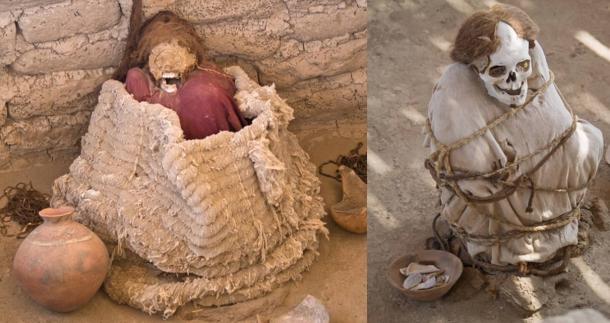Guest
Guest
 |  Subject: Hundreds of Ancient Mummies Discovered at Ceremonial Site in Peru Subject: Hundreds of Ancient Mummies Discovered at Ceremonial Site in Peru  Wed Apr 08, 2015 10:04 pm Wed Apr 08, 2015 10:04 pm | |
|  8 APRIL, 2015 - 22:13 APRILHOLLOWAYHundreds of Ancient Mummies Discovered at Ceremonial Site in PeruArchaeologists in Peru made a monumental discovery when they found dozens of tombs with up to 40 mummies in each at a 1,200-year-old ceremonial site in Cotahuasi Valley. So far 171 mummies have been discovered across seven tombs, but it is thought that there may be thousands more.The finding was made at Tenahaha, a 4 hectare site in the Cotahuasi Valley, which was established during the height of the Wari Empire (500 – 1000 AD). Very little archaeological research has been undertaken in the region due to its sheer remoteness. The Cotahuasi Canyon, sitting at 3535 meters (11,600 feet) above sea level, is the deepest canyon in the world – about twice as deep as the Grand Canyon. A number of prehistoric cultures occupied the canyon and its eastern plateau from the earliest Paleoindians to the Incas (11,000 BC – 1532 AD).MORE 8 APRIL, 2015 - 22:13 APRILHOLLOWAYHundreds of Ancient Mummies Discovered at Ceremonial Site in PeruArchaeologists in Peru made a monumental discovery when they found dozens of tombs with up to 40 mummies in each at a 1,200-year-old ceremonial site in Cotahuasi Valley. So far 171 mummies have been discovered across seven tombs, but it is thought that there may be thousands more.The finding was made at Tenahaha, a 4 hectare site in the Cotahuasi Valley, which was established during the height of the Wari Empire (500 – 1000 AD). Very little archaeological research has been undertaken in the region due to its sheer remoteness. The Cotahuasi Canyon, sitting at 3535 meters (11,600 feet) above sea level, is the deepest canyon in the world – about twice as deep as the Grand Canyon. A number of prehistoric cultures occupied the canyon and its eastern plateau from the earliest Paleoindians to the Incas (11,000 BC – 1532 AD).MORE
- Wari geoglyph similar to Nazca lines found in Peru
- Pre-Incan Culture Didn’t Rule by Pillage, Plunder and Conquest
- Human Remains found buried in walls of pre-Inca archaeological site
In recent years, archaeological research and analysis has begun piecing together the importance of Tenahaha during a period of growth and expansion from the first state-level society in the Andes and increased interregional interactions in the Cotahuasi Valley. The site is composed of a ceremonial/domestic component concentrated into a 2 hectare area, and a second component is composed of clusters of tombs located on the hillocks surrounding the ceremonial area."The dead, likely numbering in the low thousands, towered over the living," wrote archaeologist Justin Jennings, in the newly published book Tenahaha and the Wari State: A View of the Middle Horizon from the Cotahuasi Valley. The Cotahuasi landscape in Peru (Wikimedia Commons) According to Live Science, the mummies range in age from babies to adults and had been placed with their knees tucked up towards their shoulders with their arms folded across their chest. Like other burials discovered in Peru, the deceased were then tied with rope and wrapped in layers of textiles. The younger mummies, including babies and neonate fetuses, were buried in jars. Examples of traditional ancient Peruvian burials. The knees are tucked towards the chest and the body is wrapped in textiles and rope. These mummies came from the Chauchilla ancient cemetery in the desert of Nazca Peru (Source: Dreamstime) The mummies found at Tenahaha are not, however, as well preserved as those found at Chauchilla (shown above).Broken Mummies“The mummified remains were in poor shape due to damage from water and rodents,” reports Live Science. “Additionally, the researchers found some of the mummies were intentionally broken apart, their bones scattered and moved between the tombs. In one tomb the scientists found almost 400 isolated human remains, including teeth, hands and feet.”A partially disarticulated mummy found at Tenahaha. A tupu (an artifact that could have been used to fasten clothing) fell through this mummy’s rib cage when it was moved. (Credit: Willy Yépez Álvarez.) "Though many individuals were broken apart, others were left intact," Jennings wrote in the book. "People were moved around the tombs, but they sometimes remained bunched together, and even earth or rocks were used to separate some groups and individuals." Some grave goods were smashed apart, while others were left intact, he said.Researchers are not entirely sure why some mummies were broken apart and moved, while others were left in intact. However, the separation and movement of skeletal remains is a known practice to have taken place throughout the Andes. In February this year, archaeologists investigating a religious complex in Bolivia discovered an ancient mortuary where human body parts were stripped of their flesh, cleaned, and transported, making them what archeologist Scott C. Smith called “portable ancestors”. MORE
- The little-known Pachacamac mummies of Peru
- Peruvian child mummy with elongated skull undergoes analysis
- The 7,000-Year-Old Chinchorro Mummies of the Andes
Recently-discovered bones found in an ancient mortuary in Bolivia (Photo: Scott C. Smith) "In the Andes, death is a process, it's not as if you bury someone and you're done," Jennings told Live Science in an interview."The breakup of the body, so anathema to many later groups in the Andes, would have been a powerful symbol of communitas (a community of equals)," wrote Jennings in the book.A Peaceful Retreat?Archaeologists found little evidence of violence at Tenahaha, such as cranial injuries and defensive fortifications, and even recovered intricately decorated pottery with depictions of happy and smiling faces. This is in stark contrast to the situation occuring in the rest of Peru at the time, roughly between 800 and 1000 AD. Researchers have found evidence of significant violence during this period stemming from a period of tumultuous change, with rapidly expanding populations and increases in class differences.“In some areas of Peru, scientists have found pottery containing drawings of fanged teeth and human trophy skulls (skulls that could have been taken in battle),” Live Science reports. Ceramics at Tenahaha are decorated with smiling faces, while pottery found in other parts of Peru tends to be grimmer with images of trophy skulls and fanged teeth. (Credit: Justin Jennings.) Based on these findings, archaeologists have hypothesized that Tenahaha may have been a peaceful retreat, where people could escape some of the tensions occurring in other parts of Peru at the time."It's a period of great change and one of the ways which humans around the world deal with that is through violence," Jennings told Live Science. "What we are suggesting is that Tenahaha was placed in part to deal with those changes, to find a way outside of violence, to deal with periods of radical cultural change."By April Holloway
Read more: http://www.ancient-origins.net/news-history-archaeology/hundreds-ancient-mummies-discovered-ceremonial-site-peru-002880#ixzz3WmFxzF7d
|
|





